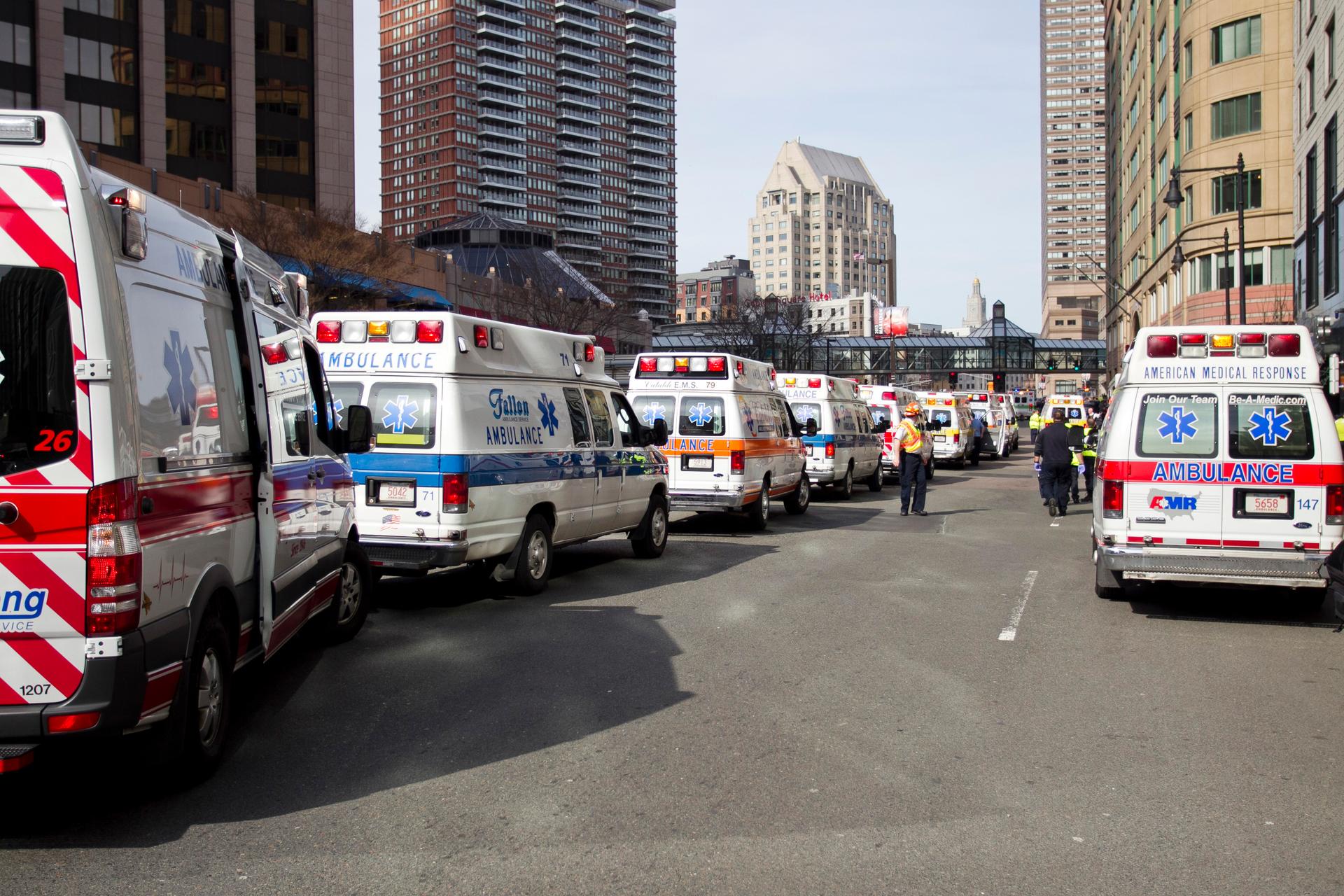Ambulances line the street after bomb explosions interrupted the running of the 117th Boston Marathon in Boston.
Emergency-room doctor Isabelle Catala was at home in Paris watching the France-Germany soccer game on TV when it was interrupted by news of the Paris terrorist attacks.
She called the emergency room to see if she should come in. They didn’t end up needing her, but she wrote an article later for the website Medscape about how the emergency response worked that night. Rather than automatically racing victims to the ER, first responders set up what they call an "advanced medical post" near the Bataclan concert hall, where most of the victims were.
“You stop everything, and you put it in the middle of the street,” Catala said.
The emergency response to the terrorist attacks in Paris was credited with saving lives, but it was a different approach than the response Boston saw to the 2013 Boston Marathon bombing. Emergency responders say comparing the two emergency models can help us prepare for possible future attacks here.
First responders in Paris divided victims into three categories based on the severity of their injury — sending the most serious cases to operating rooms or emergency departments. People who weren’t as seriously injured were treated right there in the street.
"You said, 'Please do not go to the hospital. They've got too many people really injured, so please do not go to the hospital. Go tomorrow,'" Catala said.
Catala acknowledges they may have lost some time getting the most serious cases into the operating room, since victims were first taken from several attack sites to that field hospital in the street. But French emergency responders are especially well equipped to work in the field, because they have a different way of doing things. The US model is often called "scoop and run": Basically, get the patients to the ER as quickly as possible. The French model is referred to as "stay and play." When you call the French version of 911, the emergency system there, known as SAMU (Service d'Aide Médicale Urgente, or Urgent Medical Aid Service), sends a doctor in the ambulance.
"It's the hospital coming to your house," Catala said. "And this SAMU can stay in your house for hours in order to treat you right on site, and then bring you to the hospital, which is a totally different thing from the US.”
Maureen McMahon, director of emergency preparedness at Boston Medical Center, was there the day they rushed victims of the Boston Marathon bombing into the operating room.
“Eight minutes after the first bomb went off, we had our first patient already,” she said. “Because the definitive care was the OR’s. They had to stop the arterial bleeds, and that couldn’t really be done as effectively in the field, or in the emergency room, as it could be in an operating suite.”
Since the marathon had a medical tent already set up, it was used to triage bombing victims, so the response was actually similar to Paris's.
“The difference, though, would be what do we do with the lesser injured?” Catala said.
Dr. Ricky Kue, the associate medical director of Boston EMS, Police & Fire, and a physician at Boston Medical Center, was in the tent that day, and says the medical responders tried to minimize the patients’ time there.
“So if that meant taking some of the minor injured or lesser acute patients and still transporting them to get them seen, but to get them off the immediate area, that was one of the other goals we had in mind that day,” Kue said.
Dr. Brian Barnewolt, chair of emergency medicine at Tufts Medical Center, said it was amazing that every patient who made it to the hospital survived.
"I think that speaks volumes for the trauma system in Boston,” he said.
Paul Biddinger, the director of the Center for Disaster Medicine at Massachusetts General Hospital, is careful not to criticize the French first responders, but says their system is probably not right for the US
“It’s much more resource intensive, and philosophically, many of us believe it does not produce better outcomes,” he said.
Biddinger says there needs to be more research about which model of response is better.
“Probably not surprisingly, when we don’t have data, the debates are very fierce because it’s hard to tell who’s right,” he said.
Although the attacks in Paris and Boston were quite different, the truth is there are probably more similarities in the medical response to them than there are differences. But doctors in Boston say it’s in looking at the differences, and at what worked better, that we can figure out the best response, and be as ready as possible if something were to happen here that’s even worse than what we’ve already seen.
This story was originally published by our partners at WGBH News.
